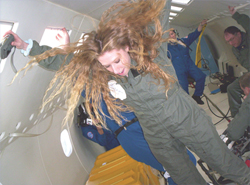| Anybody Seen my Comb? |
 |
| Photo credit: Vinaya Sathyasheelappa Teacher Lori DiLisi of Beaumont High School in University Heights, Ohio flies through the air with the greatest of ease in the weightless environment aboard NASA's reduced gravity C-9 airplane. |
Vinaya Sathyasheelappa, APS World Year
of Physics Project Coordinator, joined the teachers aboard NASA’s Weightless Wonder. Here’s his description of being in Zero-G:
The day began early. Our daily morning briefing consisted of some housekeeping items, flight conditions, scheduling, etc. Following that, we had our medical briefing. A NASA flight surgeon, who accompanies each flight, issued all the team members a dose of anti-nausea medication. (Most people, including the crew members, take the meds. It just makes it easier.) Flyers briefed, meds were taken, and then finally, we were airborne.
Even though they had warned me that the experience was very unlike the sensation of riding a roller coaster, I fully expected it to be very much like that. Boy, was I wrong...in a good way. The transitions from 2-g to zero-g were very, very smooth. One minute, you’re plastered to the floor of the plane and the next minute you’re floating around in the cabin. Luckily, I didn’t get sick. (NASA says that only 20% of flyers experience mild discomfort.)
Weightlessness is sort of like swimming. Except there is no friction from the water, although you do feel buoyant. You aren’t able to propel yourself by flapping your arms or legs. You need to push off something; otherwise, you'll just float there. Somersaults were a little bit difficult, but only because you have to push off from the floor (or ceiling) of the plane.
We conducted 42 parabolas in all. The last two parabolas simulate Lunar and Martian gravity, which are a lot different than zero-g. Lunar gravity looks and feels like you’re hopping on the ground and floating at the same time–just like you remember from footage you’ve seen of the lunar walks. Martian gravity feels like you’re very strong. People were doing push-ups with four people standing on their backs.
I can truly say that this was one of the most amazing–and exciting–experiences of my life. Was I scared? Yes, a little bit. but more of being sick on the flight. Would I do it again? In a heartbeat. Hopefully, I won’t have to wait until 2105!
More about Vinaya’s experience and pictures can be found online in the Vomit Comet Blog:
www.physicscentral.com/freefall
©1995 - 2024, AMERICAN PHYSICAL SOCIETY
APS encourages the redistribution of the materials included in this newspaper provided that attribution to the source is noted and the materials are not truncated or changed.
Associate Editor: Jennifer Ouellette
Staff Writer: Ernie Tretkoff
August/September 2006 (Volume 15, Number 8)
Articles in this Issue

